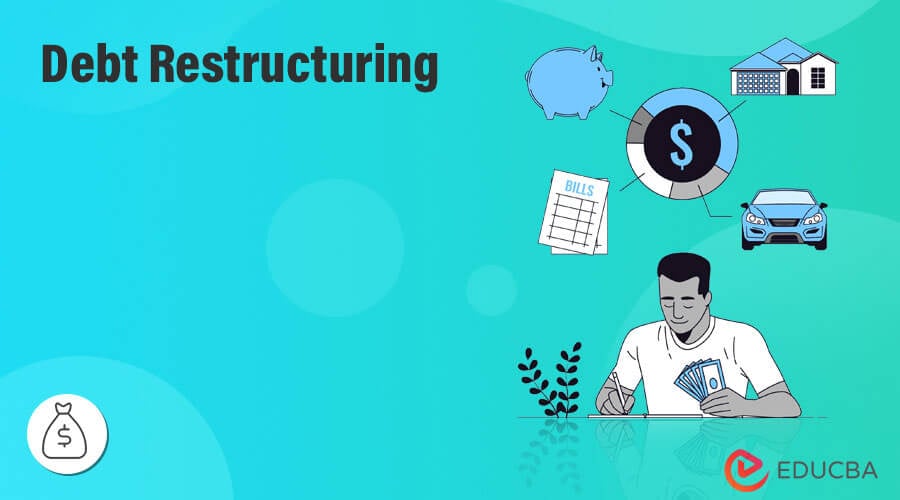Updated July 13, 2023
What is Debt Restructuring?
Debt restructuring is a process of reducing the risk of financial distress from the company. The risk of default can also be controlled through this method. The interest rates can also be reduced by restructuring the debt of the company. It is a process that involves less expense than any other method used to control the company’s debt structure.

How Does it Work?
Companies opt for debt restructuring when they are about to face bankruptcy. In this process, the interest rates are reduced to a level that helps the company save itself from getting bankrupt. By adopting this process, the company can improvise in paying off its liabilities on time. The process is advantageous for both parties. The company regains its business, and the creditors also get some time in return as compared to the situation if the company faces bankruptcy.
Types of Debt Restructuring
There are mainly three methods by which a company can opt for debt restructuring. Debt for equity swaps, Bondholder Haircut, Informal debt repayment agreements.
1. Debt for Equity Swap
Debt for equity swaps is being used by the companies when the company reaches the bankruptcy stage. In this situation, the creditor agrees to adjust its debts with the company’s equity. This type of adjustment is done when the company faces serious financial disturbances. The creditors take control of the business in this scenario. The debt for equity swap is generally recognized when there are large assets, and the business was well established. Therefore, the creditors can enjoy this opportunity as a going concern.
2. Bondholder Haircuts
The bondholder haircut is also a type of debt for equity swap. A bond haircut means an interest rate lower than the market rate on any asset being used as collateral. It also works as a cushion for a loan. In bondholder haircuts, the interest rates are reduced to lower limits so that the bondholders can invest in the securities.
3. Informal Debt Repayment Agreement
In this type of informal debt repayment agreement, if the defendants cannot pay the enforcement officer in full, they can enter into a contract with the enforcement officer to pay in installments. The settlement in this method is dependent upon the creditors and the enforcement officers. It is advised that the defendants should not pay more than they afford. This process is cheaper and easier to perform. As the name suggests, an informal debt repayment agreement is informal, and very few formalities are involved.
Debt Restructuring vs Debt Refinancing
- Debt Restructuring is done when the company faces financial distress. The entire debt process is required to change, whereas the debt refinancing is referred to as the new contract often agreed at better terms.
- Debt refinancing is a broader term as compared to debt restructuring.
- It is done in special circumstances and can adversely affect the company’s credit score, whereas, in debt refinancing, the credit score is improved, which gives benefits to the company.
- The debt restructuring process may not cut short the interest rate, whereas the debt refinancing process can cut short the interesting process.
How to Achieve it?
There are a few typical methods by which debt restructuring can be achieved. The easiest way to achieve it is to reduce the interest rate and reduce the amount payable towards the debt. In this, the creditors also play a vital role, i.e., they help reduce the company’s debt burden. It can also be achieved by doing equity swaps, and this method is one of the effective methods of debt restructuring. Sometimes, new debt is injected, which can waive off the old debt and may carry a lower rate of interest, and thus this will help in debt restructuring.
Debt rescheduling is another method that helps in the debt restructuring of the company. It helps to consolidate all the existing debts to a single lender; therefore, this may impact the payment sequel of the company, and in return, debt restructuring is possible. Some organizations also believe that if they combine their personal and business debts, then they can achieve debt restructuring. While this is not applicable to all companies but it can help some companies per convenience.
Reason for Debt Restructuring
This process helps to solve the financial crisis of the company. The bankruptcy can be avoided by restoring the liquidity of the company in a proper manner. Through the debt restructuring process, the company can also get relaxation from a legal perspective as well. The company assets can also be safeguarded with this process of debt restructuring. This process also involves the creditors for better recovery, and the creditors of the company can play a vital role in building up the company’s economy at this crucial time. This process is also cost-effective, and therefore most organizations plan debt restructuring for their companies.
Key Takeaways
- This process can help the company to get free from legal obligations.
- It has been proved that this method is cost-effective and can be used to benefit the entire company.
- The creditors also play a very vital role in this process. The companies can reach out to them for some informal debt repayment settlements.
- The companies have experienced that they have gained benefits from this process, and therefore this process is being used by most corporates.
Conclusion
Restructuring is referred to as a corporate management term. There are several reasons why restructuring is done. First, it is done to safeguard the company from financial distress. This process also helps to solve the liquidity problem faced by the companies. The companies are getting benefits from this process, and thus this restructuring process is gaining popularity amongst the corporates.
Recommended Articles
This is a guide to Debt Restructuring. Here we discuss the definition, working, and types along with the reasons. You may also have a look at the following articles to learn more –

